|
| | Albino Cynotilapia sp. afra Cobwe |  |
| | | Author | Message |
|---|
nick a
Sergeant


Posts : 113
Location : Austex
 |  Subject: Albino Cynotilapia sp. afra Cobwe Subject: Albino Cynotilapia sp. afra Cobwe  8/9/2010, 11:34 am 8/9/2010, 11:34 am | |
| The History of the Albino Cynotilapia Afra Cobwe I am not usually a fan of albino forms of any species. Besides a few albino BN’s kept for utilitarian purposes, these are the first, and still the only, albinos in any of my tanks. There are several reasons why this particular variation has caught my attention. One part of the allure this anomaly has for me is in its newness and in its ‘discovery’ within the tight proximity of my circle of friends. Another part is that these guys are just flat-out stunning! You cannot walk past a tank housing a mature group of these fish without stopping to take a better, longer look. The fact that this is a naturally occurring deviation versus something like the cross used to achieve the OB Peacock has a huge impact on my desire to maintain, propagate and disperse their offspring. Because I think this beautiful fish is bound to become a sought after staple in the hobby and while they’re still of relative recent development and of limited availability, I figure it’s worthwhile to put together a bit of a history for them. Unfortunately, I have been unable to contact “Sharkie”, as he is known on many forum boards, to go over and refresh my information on the early portion of this history. I’ll have to go with Doc’s, David Dockwiller’s, and my best recollections and update if any discrepancies occur. Sometime in 2003, “Sharkie” purchased two pairs of WC C. afra Cobwe from Armkes. He housed them in a 110 or 125 with groups of Ps. polit, Ps. flavus, Met. msobo and other species. Each of the males set up a territory on opposite ends of the tank and each had a successful spawn that “Sharkie” was able to collect the fry from. “Sharkie” gave a trio of these F1s to Doc’s mother for her Malawi tank. Sometime shortly after that, one of the WC males {#1} killed the other male {#2} and claimed the females for himself. The now trio of afras produced many spawns. “Sharkie” was transitioning into Lake Tanganyikan cichlids during the summer of 2004 and sold the remaining male and two females to me. He also included a very nice F1 female from the spawn of the deceased male in the deal. He’d added her to the trio because she had such fantastic coloration for a female. Doc’s F1 trio and my ‘new’ original group were quite productive in their new homes. Doc’s trio produced a batch of fry that included three unusual looking individuals. As they got some size, Doc was able to see that they were albinos. While he had no luck getting these 2 males and single female to spawn, he was able to collect a complete new batch that had approximately 25% albino fry. Assuming roughly 25 fry from a normal spit, that would be 6 or 7 albino fry per spit. Over the next 2 years, he was able to grow these and subsequent fry batches out and eventually get F2 albino X F2 albino spawns that produced 100% F3 albino fry. He established a solid breeding colony which produced quite a few fry. The albino C. afra Cobwe that began showing up on Aquabid, at Dave’s Rare Aquarium Fish and at River City Aquatics during the mid-part of 2006 were all from Doc’s group. Towards the mid part of 2007, Doc also felt the urge to move away from Mbuna and into more Lake Tanganyikan and West African cichlids, so he ended up putting his entire breeding group up for sale. Evidently, someone in the central Texas area purchased the group. I have yet to see more batches of the F3 albino fry/juvies available through local channels however. Doc was kind enough to share a male and two female juvies from his line with me before he closed out his colony. I know of several individuals across the country who purchased males with the hope of crossing the albino males with normal females and starting their own lines. I’ve tried to stay in touch with a few of these folks and am attempting to contact some others---more about this later in the story. Male from Doc’s line: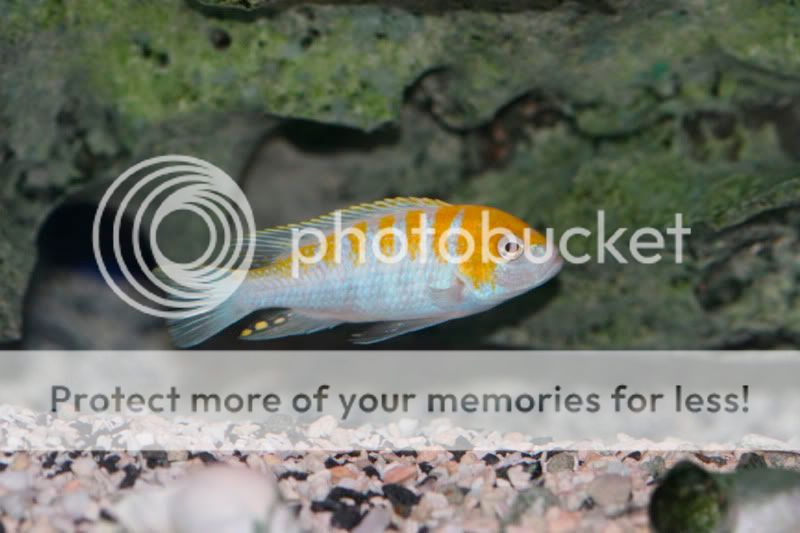 Photo by Doc Dockwiller (w/permission)Male from Doc’s line: Photo by Doc Dockwiller (w/permission)Male from Doc’s line: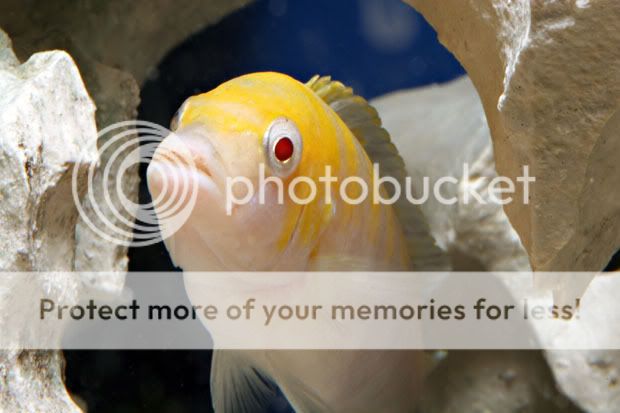 Photo (used on Aquabid auctions) by Jennifer Prince (w/permission) Photo (used on Aquabid auctions) by Jennifer Prince (w/permission) Back to the original group I got from “Sharkie”. I kept that group for several years and had many, many spawns from all three of the females. I’ve been able to trade, sell and just share fry/juvies from this group throughout those years. Towards the mid part of 2006, breeding had slowed significantly and the trio was beginning to show signs of aging. I kept about ½ of the last batches of fry from each of the females before putting them and the old male out to pasture in various friends tanks. I grew the combined group of fry out in a 40BR until the males began to color up. Unfortunately, about this time a number of things were going on in my non-fish world that didn’t allow me to spend as much time as I would have liked on this group and they began spawning in that tank –before I was able to thin down the heavily male population or to have a chance to collect any of the batches of fry. As normal in reasonably rocked tanks, there were a few survivors from each spit. I happened to note that one or two of these survivors had a very distinct look to them and on further scrutiny seemed to be albinos. I was unable to rescue them at that time and they evidently didn’t make it out of the food chain. I had no idea which of the pairings occurring in the 40BR had produced the albino fry and just flat didn’t have the time or space to try a long-drawn-out process of elimination. So I thinned the F1 group down to one male/four females and traded off the rest; knowing that I had Doc’s nice trio of albinos already. I moved the group to their new 75 and breeding began in earnest. As luck would have it, every spit from one of the four females produces albino fry! I have several of her batches growing out now. None of the other three female’s spits have produced anything but normal fry. I haven’t separated the young albinos from their normal brothers and sisters. All behavior within the group seems to be identical to any other batch of afra fry. There is a similar range in size and growth within the albinos; some are larger/quicker growers, some the opposite and most are in the middle. This chart shows what we’ve been able to deduce of the probable sequence of spawns. It appears that the loss of Male #2 was of more significance than any of us suspected at first. It is likely that he was the carrier of this trait and that his early demise really narrowed the window for someone like Doc to note and then save this anomaly. 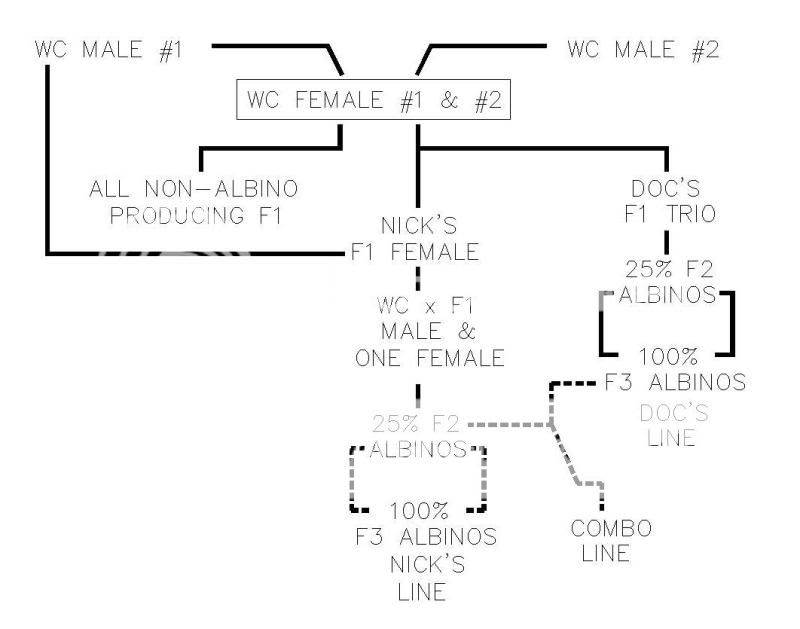 It was also very fortunate for “Sharkie” to have noted the uniqueness of that one F1 female because through her I now have a 50% different bloodline of albinos. I intend to follow Doc’s lead and mate the F2 albinos and create 100% broods and will hopefully have the opportunity to cross the two lines and create the ‘combo’ line. I’ve called the unrelated WC x F1 offspring F2—some would call them F1—but it’s not an argument necessary in the scheme of this article. As stated above, I’ll continue to stay in contact with and try to reach out to a few other folks who are attempting to create their own 50% different bloodlines in the hopes of trading fry from each line and doing the best we can to keep the long term diversity and robustness of this truly beautiful variation of C. afra Cobwe alive, healthy and available in the hobby for years to come. Originally published in part in the HCCC monthly magazine, The Lateral Line.
Update as of 10-2009. I’ve been successful in collecting the 25% F2 fry from the Nick’s line and have built a nice breeding colony of this generation which has been producing the 100% F3 batches with solid regularity. I’ve been able to send F3 fry to folks around the country to start colonies as well as to supply Dave with a fair number of batches to disburse. Another fortuitous event was that among the female F2s I kept for my breeding colony, one of them has a very unusual, very yellow color pattern. I’ve isolated a batch of fry from this female and am in the process of growing that batch out. They are currently 1.5-2” and should start coloring up soon. I can’t wait to see if any of the females share their mother’s coloration! I plan on keeping several of the F4 batches from this group to see if the yellow trait becomes more predominant. Always something to look forward to in this hobby! 8-9-10 I'll add photos below this post so they don't need constant reload. | |
|   | | nick a
Sergeant


Posts : 113
Location : Austex
 |  Subject: Re: Albino Cynotilapia sp. afra Cobwe Subject: Re: Albino Cynotilapia sp. afra Cobwe  8/9/2010, 11:41 am 8/9/2010, 11:41 am | |
| This is the 'normal' male who produces 25% albino fry with only one of the females I kept in the group.  A male from "nick's" line.  A more usual whitish female with the yellow morph female.  | |
|   | | Holey Rock of Texas
Admin


Posts : 6531
Location : Dallas, TX
Favorite Fish: : shellys
 |  Subject: Re: Albino Cynotilapia sp. afra Cobwe Subject: Re: Albino Cynotilapia sp. afra Cobwe  8/9/2010, 11:47 am 8/9/2010, 11:47 am | |
| | |
|   | | istrober
Moderator


Posts : 2643
Location : Lehigh Acres, Fl
Favorite Fish: : Africans, Peacocks, Catfish.. pertty much everything that has fins and tail...
 |  Subject: Re: Albino Cynotilapia sp. afra Cobwe Subject: Re: Albino Cynotilapia sp. afra Cobwe  8/9/2010, 11:51 am 8/9/2010, 11:51 am | |
| wow what kind of camera you use to take those amazing pics lol, give us the tip!!!  | |
|   | | KMX
Admin


Posts : 16094
Location : Mansfield, TX
Favorite Fish: : African Cichlids of all kinds.
 |  Subject: Re: Albino Cynotilapia sp. afra Cobwe Subject: Re: Albino Cynotilapia sp. afra Cobwe  8/9/2010, 11:57 am 8/9/2010, 11:57 am | |
| Way to cool nick. keep us updated on the story. I love Mbuna and would really love some of these in a few months once I get my new rack and tanks set up. Thanks for the article.  | |
|   | | BFinley
Admin

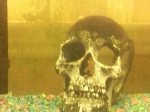
Posts : 4498
Location : Fort Worth,Tx
Favorite Fish: : Frontosa and Red Tail Catfish and All Africans
 |  Subject: Re: Albino Cynotilapia sp. afra Cobwe Subject: Re: Albino Cynotilapia sp. afra Cobwe  8/9/2010, 12:01 pm 8/9/2010, 12:01 pm | |
| Love the pics!!!  | |
|   | | nick a
Sergeant


Posts : 113
Location : Austex
 |  Subject: Re: Albino Cynotilapia sp. afra Cobwe Subject: Re: Albino Cynotilapia sp. afra Cobwe  8/9/2010, 12:04 pm 8/9/2010, 12:04 pm | |
| Both female types are 'attractive' to the males   The male in the group from Doc. 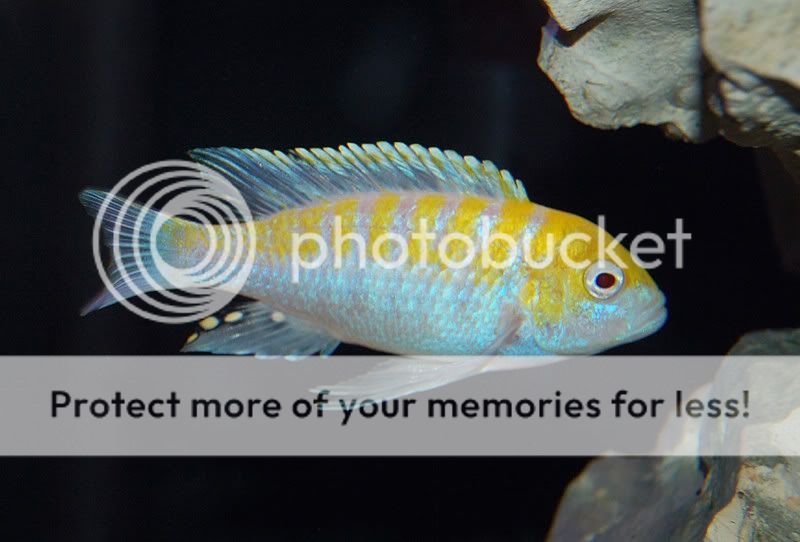 I'm sure some from one line or the other will be here when you're ready fro them K. I'm using a basic DSLR, nikon D50, with the lens that comes with the kit {nothing too fancy or huge $} and a whole lot of time & patience  Most important thing is to clean the glass inside and out before even sitting down to try some shots. | |
|   | | istrober
Moderator


Posts : 2643
Location : Lehigh Acres, Fl
Favorite Fish: : Africans, Peacocks, Catfish.. pertty much everything that has fins and tail...
 |  Subject: Re: Albino Cynotilapia sp. afra Cobwe Subject: Re: Albino Cynotilapia sp. afra Cobwe  8/9/2010, 12:05 pm 8/9/2010, 12:05 pm | |
| Good tip nick ill keep it in mine!!! Thanks..  lol basic camera??? i dont think i can afford one of those right now lol, i just have a nikon too but its very basic $120.. http://www.nikonusa.com/Find-Your-Nikon/Product-Archive/Digital-SLR/25216/D50.html | |
|   | | Sponsored content
 |  Subject: Re: Albino Cynotilapia sp. afra Cobwe Subject: Re: Albino Cynotilapia sp. afra Cobwe  | |
| |
|   | | | | Albino Cynotilapia sp. afra Cobwe |  |
|
Similar topics |  |
|
| | Permissions in this forum: | You cannot reply to topics in this forum
| |
| |
| | Who is online? | In total there are 68 users online :: 0 Registered, 0 Hidden and 68 Guests :: 2 Bots
None
Most users ever online was 885 on 4/28/2021, 6:39 am
|
| Latest topics | » New To Site
 by Bishop 9/2/2022, 1:33 pm by Bishop 9/2/2022, 1:33 pm
» I'm BACK !!!!!
 by KMX 2/28/2019, 2:26 pm by KMX 2/28/2019, 2:26 pm
» USA coming back?
 by lgsasquatch 1/12/2019, 9:06 pm by lgsasquatch 1/12/2019, 9:06 pm
» -SL- Terrys Stocklist
 by Terry 1/9/2019, 9:36 am by Terry 1/9/2019, 9:36 am
» A look a my Set up!
 by BBurton 1/8/2019, 8:55 pm by BBurton 1/8/2019, 8:55 pm
» Send in your January POTM contest pics
 by ilicurtisili 1/7/2019, 1:55 am by ilicurtisili 1/7/2019, 1:55 am
» Salutations
 by BFinley 2/19/2017, 11:52 am by BFinley 2/19/2017, 11:52 am
» Hello everyone
 by daenduckstreek 1/13/2017, 8:07 pm by daenduckstreek 1/13/2017, 8:07 pm
» Hypancistrus (Colony Only) Sale - Shipping available - Allen TX
 by katiebear22 5/9/2015, 4:55 pm by katiebear22 5/9/2015, 4:55 pm
» WTB L46 Zebra Plecos 2.5" or larger
 by katiebear22 5/9/2015, 4:53 pm by katiebear22 5/9/2015, 4:53 pm
» algae prob please help!!!
 by wblueus 1/1/2015, 9:06 pm by wblueus 1/1/2015, 9:06 pm
» New to Fishbox
 by MitziK 12/28/2014, 9:57 pm by MitziK 12/28/2014, 9:57 pm
» Hello!
 by DreamFa11 12/26/2014, 3:06 pm by DreamFa11 12/26/2014, 3:06 pm
» -SL- proyect01
 by proyect01 8/31/2014, 10:52 pm by proyect01 8/31/2014, 10:52 pm
» New to this forum
 by proyect01 8/31/2014, 10:49 pm by proyect01 8/31/2014, 10:49 pm
» Newbie
 by proyect01 8/31/2014, 10:46 pm by proyect01 8/31/2014, 10:46 pm
» Howdy...again!
 by proyect01 8/31/2014, 10:44 pm by proyect01 8/31/2014, 10:44 pm
» Hi Everyone
 by proyect01 8/31/2014, 10:43 pm by proyect01 8/31/2014, 10:43 pm
» Fort Myers, FL New Member
 by proyect01 8/31/2014, 10:40 pm by proyect01 8/31/2014, 10:40 pm
» Hello
 by proyect01 8/31/2014, 10:38 pm by proyect01 8/31/2014, 10:38 pm
» people in the dfw area.
 by koicrazy 8/8/2014, 3:12 pm by koicrazy 8/8/2014, 3:12 pm
» where is the best place to get food for baby bettas?
 by Dr. Who 6/20/2014, 9:32 pm by Dr. Who 6/20/2014, 9:32 pm
» Water changes
 by Dr. Who 6/20/2014, 9:31 pm by Dr. Who 6/20/2014, 9:31 pm
» Anyone interested in - Samazi Frontosa - Mechanicsville, VA
 by Vikings 28 6/12/2014, 8:22 am by Vikings 28 6/12/2014, 8:22 am
» Looking to buy Frontosa's
 by Vikings 28 6/12/2014, 8:17 am by Vikings 28 6/12/2014, 8:17 am
|
|
